To combat feeling overwhelmed by the climate crisis, I’ve been trying to dream up solutions instead of obsess about the problem. It’s a personal tactic that encourages a positive outlook. Which in turn helps me to weather the media barrage of floods, fires, droughts and heat waves ravaging our planet, and worsening each day. Am I a climate scientist, engineer or politician? Three times no. I’m simply a person who thinks and walks and writes – because I believe it’s going to take all of us to find ways through this crisis. So why not me? And why not you? Maybe, together, we will all manage to connect different dots… to new solutions.
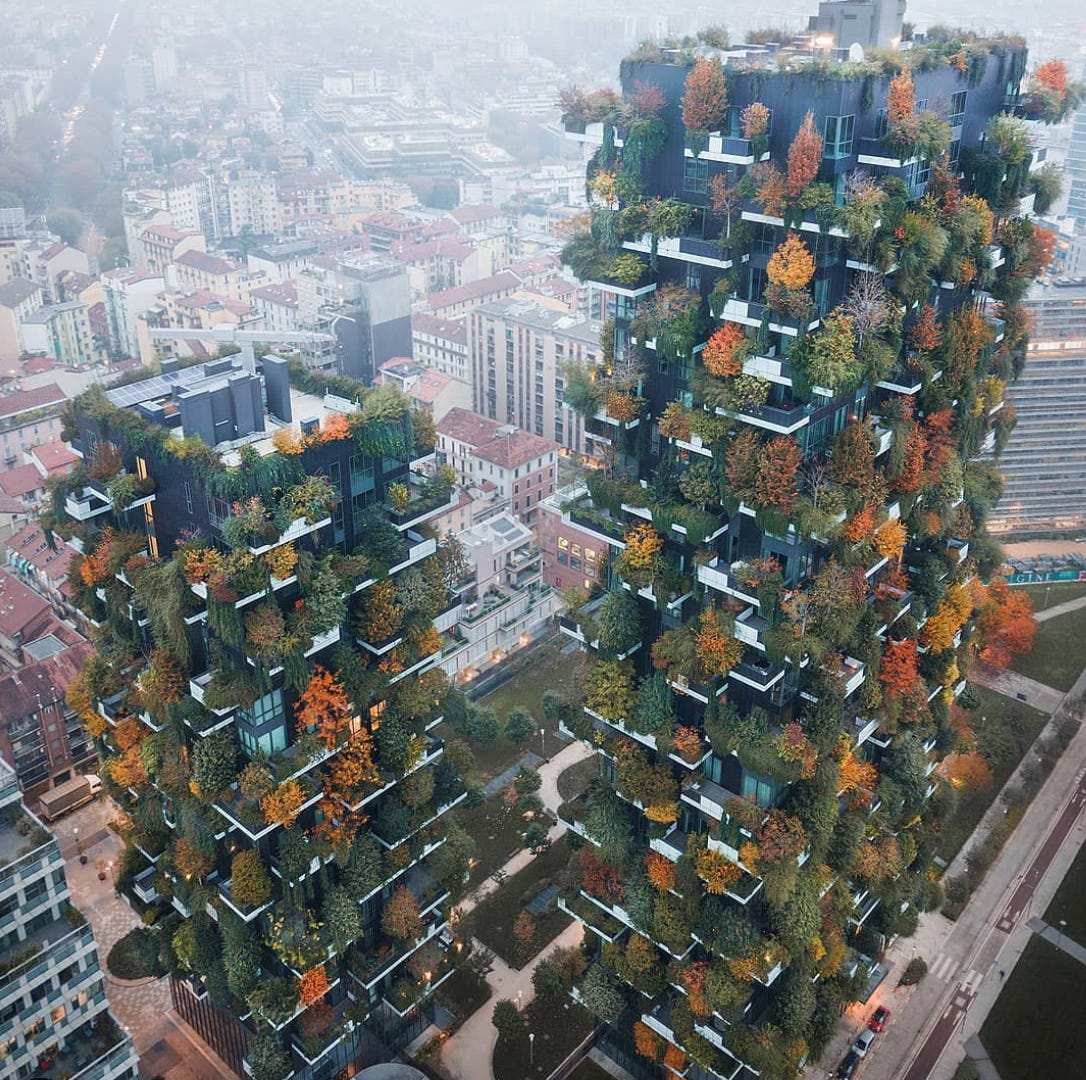
Are you familiar with the expression: Energy flows where attention goes? I like it. I find it useful. And I’m observing that it delivers real-time, actual results. Meaning: one attempt of mine to dream up solutions happened quite literally like that, while I was asleep. But when I awakened, clear ideas remained that seemed sensible enough to write down. Then in recent weeks while trying to tease some ‘actuality’ out of them, I’ve been delighted to find that parts of them already exist. The energy is flowing. So by me adding my attention and you perhaps adding yours, even more energy will flow.
The idea I dreamed up is essentially:
What if we completely overhaul our notion of how we buy & sell land? Such that: Every plot of land, whether commercial or residential, would have to devote a percentage of its footprint to creating (or maintaining) spaces devoted to nature.
And this way of transacting land would benefit from local, regional and national subsidies, policies and procedures that would make this way of operating not only financially viable, but financially attractive as well. So, no matter whether a piece of land’s designated usage was for a house, school, hospital, office building, retail venture or factory, NO place developed by human beings would be devoid of nature.
Before you dismiss this as being impossible or fanciful, let me walk you through you it. Let me explain some of the thinking that led me here, and show you examples, not from the future, but from now. Energy is flowing already. Let’s increase our attention.
Two references first. On one of my visits back to Australia, I read a study that had been done on some suburban areas in Brisbane, Queensland. It discovered that between the 1950s and the 2010s, the ‘usage’ of housing plots had changed dramatically. In the 1950s the houses were surrounded by large areas of lawns and/or flower gardens, and fruit and vegetable gardens. Trees provided shade. Parents worked and/or relaxed in their gardens, and children played outside, getting plenty of fresh air and exercise. The picture in the 2010s however, looked completely different. The houses had grown much bigger (on the same-sized plots of land), and the gardens had shrunk exponentially, or been entirely paved over. With drastic consequences.
The microclimate of this suburb had spiked upwards into being much hotter and drier. Because of all the paving and the increase in house sizes, when rain would fall, there was far less soil for the water to soak into. This meant that drainage systems were more susceptible to flooding during downpours. Because both adults and children were eating far less fresh food that they had grown themselves, obesity had increased, often leading to conditions like type-2 diabetes. This was proving to be of particular concern amongst the children, who were no longer playing outside, but were indoors on their mobile devices and video games, which in turn was leading to mental health problems from a decrease in social skills learned through outdoor play with other children. You get the picture, yes?
Reference Two. Since 2004, I’ve been spending increasing amounts of time in Brabant, a province of the Netherlands where my husband (and his ancestors) grew up. The Netherlands has a high population density. For Australian readers: it’s like putting the entire Australian population into a space around half the size of Tasmania. As Amsterdam has become increasingly crowded – 20 million visitors per year in recent years, to a city of only 1.1 million inhabitants (for comparison: Sydney, with a population of 5 million, receives only 9 million visitors per year; NOT 60 million) – we’ve been escaping to Rosmalen, near Den Bosch. In 2004 the areas around Rosmalen were incredibly green – from a combination of mixed-use farms, wooded areas, housing areas with gardens, and small parks. But over the last 20 years I’ve been watching these green spaces shrink at an alarming rate. And as more people start using more buildings, that requires more roads and parking, so more paved surfaces, and more of the kinds of buildings required to service all of these people.
Case in point: about a two-minute bike ride away, an area of farmhouses and small, farms, with plenty of trees and soil where rain water could soak into the ground, was recently torn down to make way for a new petrol station and a huge home supplies warehouse. It includes a large, paved over area for the visitor carpark. Nothing remains of the soil, the trees or the grasses. This area seems to be heading rapidly in the direction of Australian desert-like suburbs, like the one pictured above. But does this HAVE to be the case?
Of course I’m aware that sweet little farmhouses can’t always stay as they are forever. Land uses and needs change over time. But let’s return to my ‘What if…’ idea for a moment. What if instead, both the petrol station and the home warehouse were required by the local council, to devote a percentage of their footprint to natural ecosystems in their building process? Why couldn’t it be urban plus nature, instead of urban minus nature? And what if there were systems in place to support them in doing this? What if a whole new category of workforce was created, to service individuals and small companies and developers who need to ‘green’ their building projects – not only through sustainable building practices, but also by creating literal green spaces? And what if local councils all the way through to national governments, supported (and even enforced) these kinds of building practices?
The good news is that actually, I’m not dreaming. These practices already exist. In the Milan Vertical Forest, pictured above, not only has the project devoted a percentage of their footprint to natural ecosystems, it has successfully, ‘grafted the equivalent of thousands of square meters of forest and undergrowth onto a few hundred square meters of urban space.’ Then just this week I spoke with friends who are building a house in a new kind of village being created in Almere in the Netherlands. Everything is geared around integrated green spaces, community and sustainability. Urban ecologists are part of the design and building programme. Their task it is to design all the environments around and in between the houses. Residents can signal that they’re a ‘Groene Buur’ or Green Neighbour, meaning they want to actively engage with fellow neighbours in sharing gardening knowledge, cuttings and manual assistance. And the influence is already radiating outwards. One of the building companies constructing the houses has recently taken on a biologist as a full time employee, to help them construct greener spaces.
I follow Australian writer / activist / thinker / hiker Sarah Wilson, who actively engages with topics like the ones I raise above. She’s deeply concerned how capitalism has us hurtling towards both physical and spiritual destruction. And in a recent (extraordinary) conversation with collapse theorist and global leadership consultant Margaret (Meg) Wheatley they discuss how we’re already IN it. It’s no longer in the future. Our civilizations around the world are collapsing as we speak, so what should we do in response? Their suggestion is that we create ‘islands of sanity’ amid the despair, that allow us to create meaningful lives. And that’s something I’m intent upon creating here at Bright Side Writings.
However, this island of sanity won’t work if I’m the only one on it. So, I extend an invitation to you: Please consider joining me, by jotting some thoughts in the Comments below. Do you agree or disagree with things I’ve said here? Do you have additional examples of positive building practices? Let’s have conversations. Let’s share information. Let’s inspire each other. Let’s create meaning for each other.
I’d like to close with an anecdote and some photos that reference the past, but are also all about the present and the future. There’s an estate near Rosmalen called de Wamberg that has been owned by a large extended family for centuries. Some of its earliest buildings date from the 1300s. These days, parts of it are still privately owned, while other parts, including wooded areas and fields are open to the public. I love to walk there, particularly right now to enjoy the autumn colours. ‘Forest bathing’ has been proven to lower blood pressure, improve our circulation, and simply make us happier, because of the various natural chemicals we inhale, that trees are constantly emitting. As it happens, the families who lived here had a penchant for collecting and growing ‘exotic’ trees, to the degree that the Wamberg presently has eight listings on the international website of Monumental Trees, including ones for their Giant Sequoia and Pendunculate Oak.
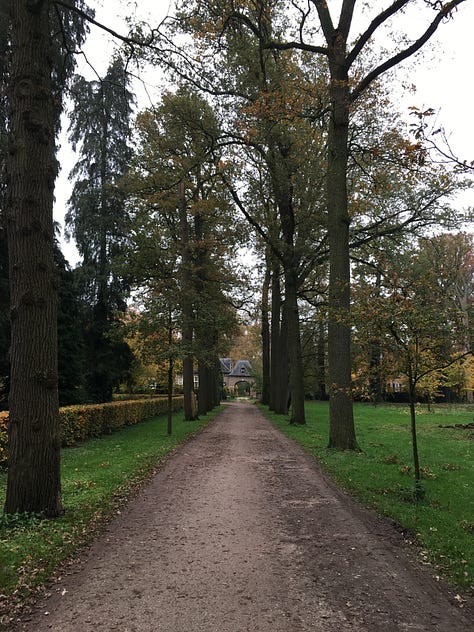
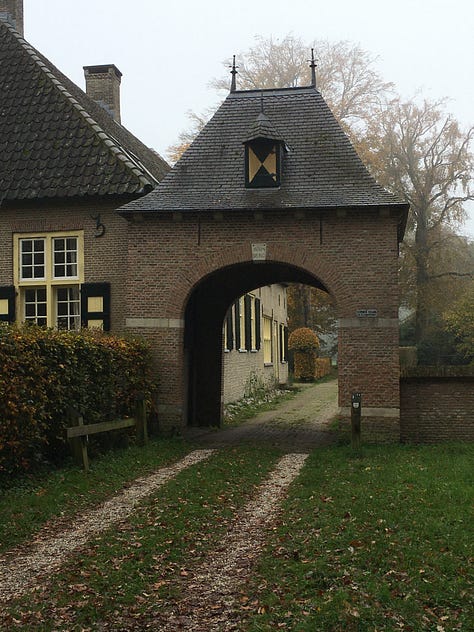
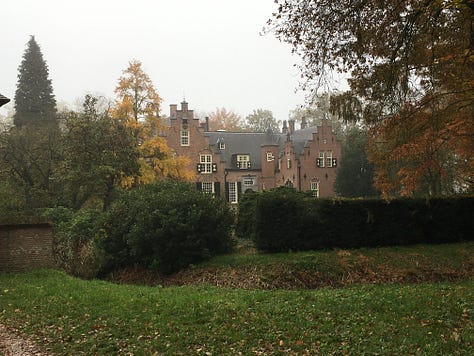
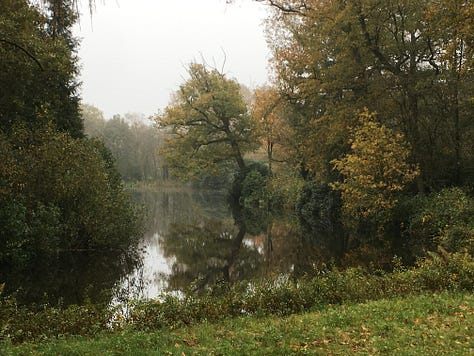
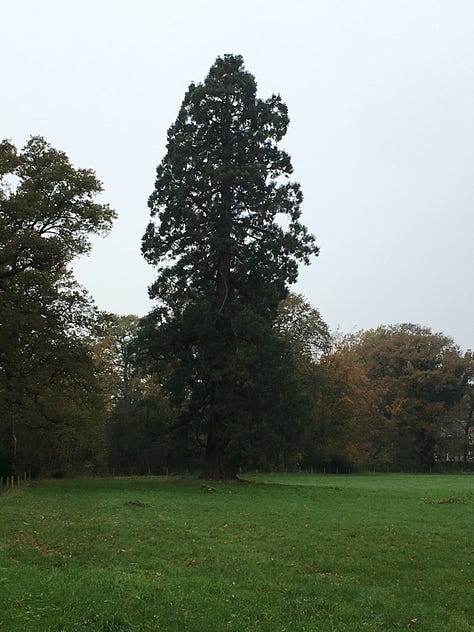
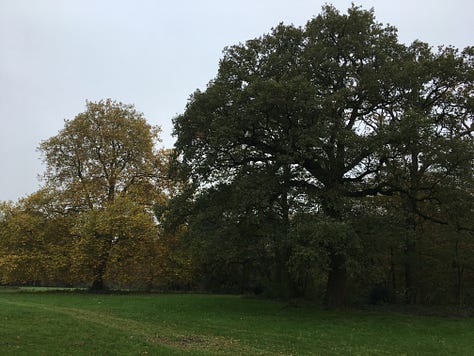
I feel incredibly privileged to have access to such a gorgeous park, as a member of the public. My mother-in-law, on the other hand, had a different kind of access, because as a young girl she was friendly with the family who lived in one of the buildings pictured here, and she used to love to play in their garden. When she grew older though, she heard a story that the owners had fallen on hard times. Like many of these families, while they might have been asset rich, they were also cash poor. Even if, in this particular instance that translated into ‘not being able to afford a new dress for an upcoming meeting with the Dutch Queen.’ My mother-in-law’s aunt however, couldn’t understand the problem. “But you have so many huge trees!” she observed. “Why can’t you cut a few down, and sell them for firewood?” Horrified at this suggestion, the Lady of the house retorted, “Because that would be TOO sad for the trees! And besides, we are their custodians. For the future!”
I would hereby like to thank that Lady for leaving us those trees. Because today, they still bring me joy and wonderment. And I would like to use the Lady’s personal conviction to remind us that we always have a choice: Will we allow ‘the tree to get cut down?’ For a short-term gain? Or will we stand by our principles, on our islands of sanity, even as things collapse around us? Will we choose to be the custodians of nature, to continue igniting faith in the human spirit? And will we continue to care for the future? I look forward to hearing your thoughts.
Love and light,
Matthew







Thank you. I'm so glad this piece 'landed' with you, Minouk. And 'attention on positive change for a better world' sounds great to me. Let's get that energy flowing!
Dreaming up solutions is fun AND finding the 'bright spots' (areas of innovation and problem solving) is also uplifting! I would suggest we look for these and support and share the hard work people are doing and the improvements they're making. In my opinion, we may not need more ideas, we may just need to amplify the ones that exist and are working for people, communities and nature.
A small city in Iowa with a population of 100,000 has created an innovative program to support native plantings on private-property residential land called the Native Roots Program. Property owners who register their lawns in the program receive lawn signage to celebrate their urban conservation efforts and educate the community on urban conservation practices that help prevent stormwater pollution and provide habitat. The city also has a 50/50 cost share to help install the native plants. These kinds of programs seem very scalable and a great example other cities can adopt.
Native Roots Program, Davenport Iowa: https://www.davenportiowa.com/services/public_works/water/stormwater__water_run-off_/native_roots_program
STORMWATER BMP (Best Management Program) 50/50 COST SHARE PROGRAM:
https://www.davenportiowa.com/cms/one.aspx?portalId=6481456&pageId=15806736
Regarding our population growth which creates more and more housing developments, people will need to adopt a different way of life with less square footage. That's an enormous culture shift especially for areas other than large cities, like New York City, where people have adapted. Additionally, in most places the US property taxes are dependent on higher and higher property values, which in many cases means larger and larger homes.